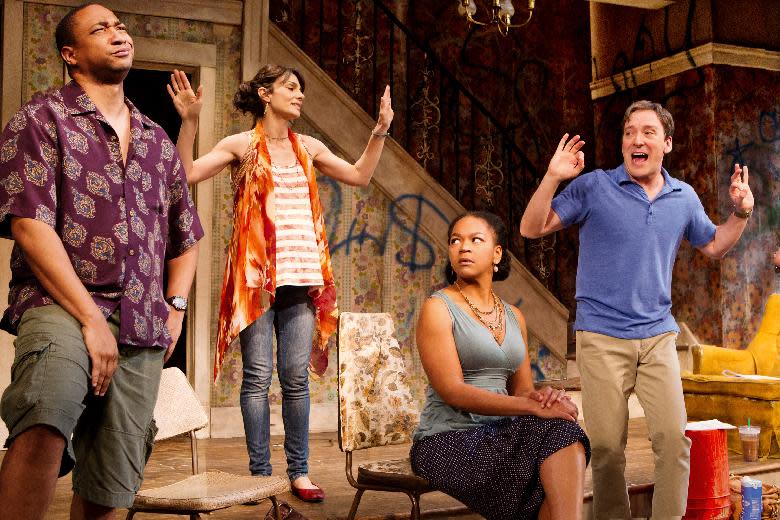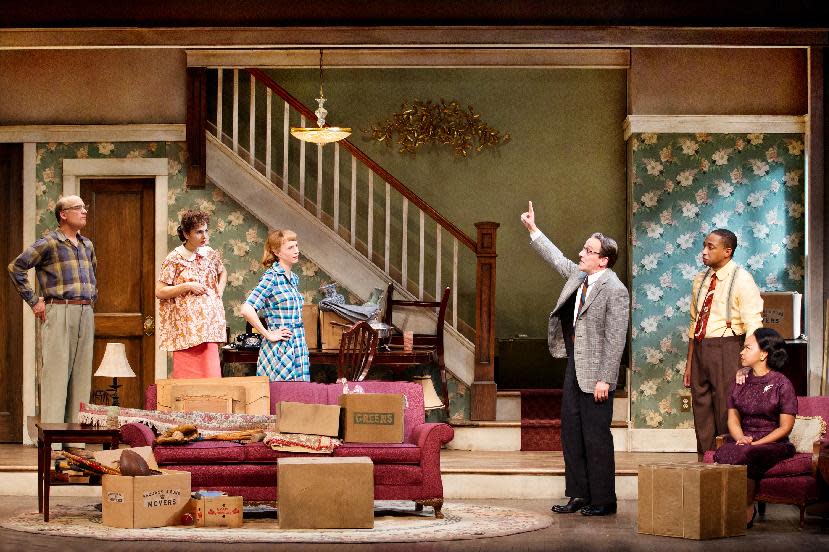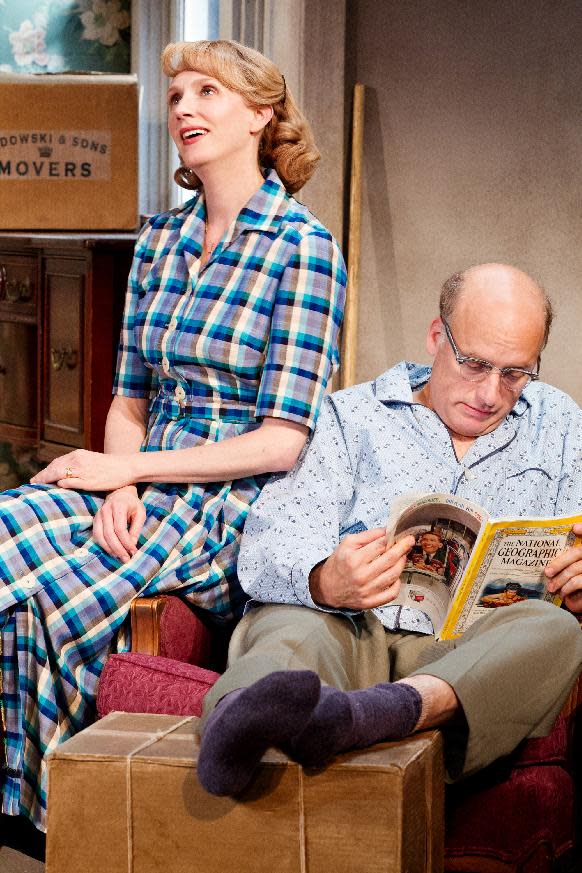Review: 'Clybourne Park' a sly gem with great cast
NEW YORK (AP) — The address 406 Clybourne Street has a special resonance in the theater.
That's the place that offers a better life in Lorraine Hansberry's play "A Raisin in the Sun" — a sunny home with a garden in a white enclave where the black Younger family in 1959 plan to move in order to escape Chicago's South Side poverty.
What happened to them there is unknown.
Enter Bruce Norris. His sly, edgy gem "Clybourne Park," which opened Thursday at the Walter Kerr Theatre, is also set at 406 Clybourne Street. Act I picks up where Hansberry left off, and Act 2 jumps to 2009, when the house is about to be demolished, but its legacy is no less emotionally charged.
"Clybourne Park" is everything you want in a play: Smart, witty, provocative and wonderfully acted by the well-knit ensemble of Crystal A. Dickinson, Brendan Griffin, Damon Gupton, Christina Kirk, Annie Parisse, Jeremy Shamos and Frank Wood. Director Pam MacKinnon lets each actor shine, pulls out the humor and is a master at the slow boil.
Separated by 50 years, the two acts of the play could conceivably stand alone, but they ingeniously connect through fragments of dialogue and neighborhood characters. Both parts end in everyone screaming, feelings hurt and couples bickering. No one is really listening to anyone else. It's terrific.
The play opens in 1959 with moving boxes littering 406 Clybourne Street. The owners — a white couple played by Kirk and Wood — are leaving the white neighborhood after feeling slighted.
They've sold their house to the Youngers, which triggers a sort of last-ditch intervention from a priest (Griffin) and an unhappy white neighbor Karl (Shamos) and his deaf wife (Parisse). Their argument: If a black family moves in, property values will plummet.
Dragged into an increasingly ugly spat on this afternoon is a black maid (Dickinson) and her even-keeled husband (Gupton). To prove that the races really shouldn't be mixed, Karl — who visited the Youngers in "A Raisin in the Sun" to try to dissuade them from moving into this house — tries to show that blacks eat differently, think differently, are different. "Do you ski?" he asks the maid.
The second act fast-forwards to 2009 and much has changed — or has it? The once-white enclave of Clybourne Park, we learn, became a black neighborhood over time, and 406 Clybourne Street is about to be demolished. Poverty and crack have hurt the neighborhood, but it's on the upswing again, with a Whole Foods moved in. Gentrification is in full swing.
A yuppie couple (Shamos and Parisse) plan to build a new home — and a koi pond — on the lot, which has triggered a last-ditch visit by a black couple (Dickinson and Gupton) who represent the homeowners association and have a family connection to the Youngers. Kirk plays a lawyer and Griffin a Realtor.
Now, the issue at hand is respecting history. The white couple — Steve and Lindsey — want to build a larger-than-normal home, and the black couple want to make sure the new owners build within the guidelines of what makes Clybourne Park so distinctive.
What does that really mean?
Enter Norris.
"Jesus, maybe we oughta save ourselves some time and, and, and, and just... say what it is we're really saying instead of doing this elaborate little dance around it," says Steve. "It's race. Isn't it?"
And that's how this meeting descends into screaming matches, inappropriate jokes, racial slurs and threats of violence. Fifty years on, Norris seems to be saying, and we are no closer to closing our racial wounds. And the inclusion of more voices — women are no longer deaf or powerless and a gay character is introduced in 2009 — has actually created even more of a din as the outrage increases.
Daniel Ostling's set for 406 Clybourne is masterful — Eisenhower-era decor in Act 1 and a graffiti-defaced one in Act 2. No detail is unchanged, even the metal numbers on the wooden front door in 1959 that become stickers on a metal security door in 2009.
The cast and their director have been together since the play debuted at Playwrights Horizon in early 2010, and it shows. There is an ease and richness to the way each actor has mastered their own timing and motivation. Overlapping dialogue is handled like a ballet.
Hard as it is to single out one actor for the highest praise, it has to be Shamos, who plays Karl with a mannered nerdiness and Steve with such a panicky exasperation that the audience as a whole seems to want to go up on stage, slap him and end his misery in each act.
The playwright weaves lovely little webs through the two acts — for example, both groups stumble over naming foreign capitals and both have to come to terms with a footlocker. And yes, whether or not black people can ski makes a snide return.
The play won the 2011 Pulitzer Prize and it is likely to keep winning this Tony season. Norris has found a deep, rich vein to mine at the intersection of race and real estate. It has found a natural home on Broadway that few neighbors will complain about.
___
Online: http://clybournepark.com





